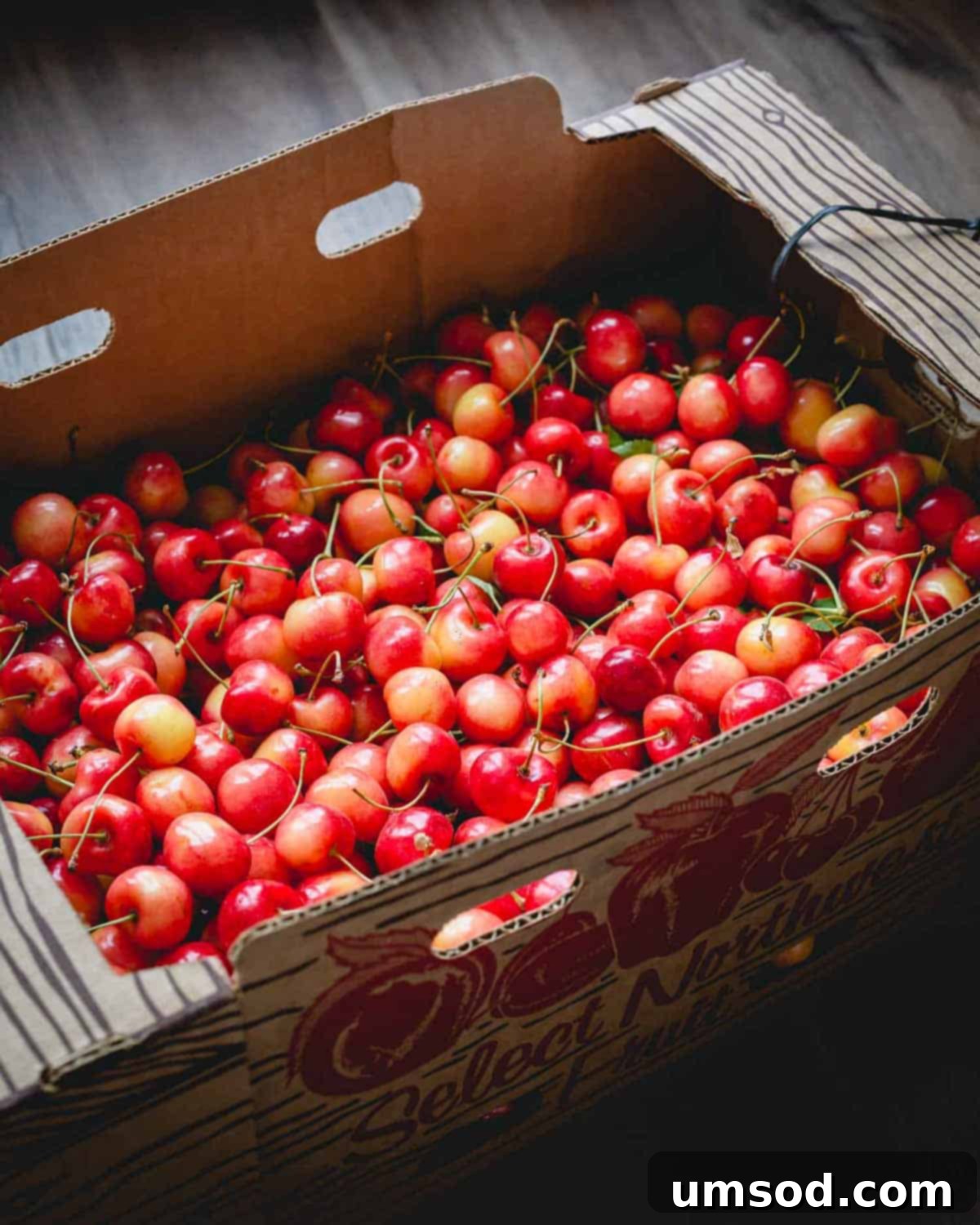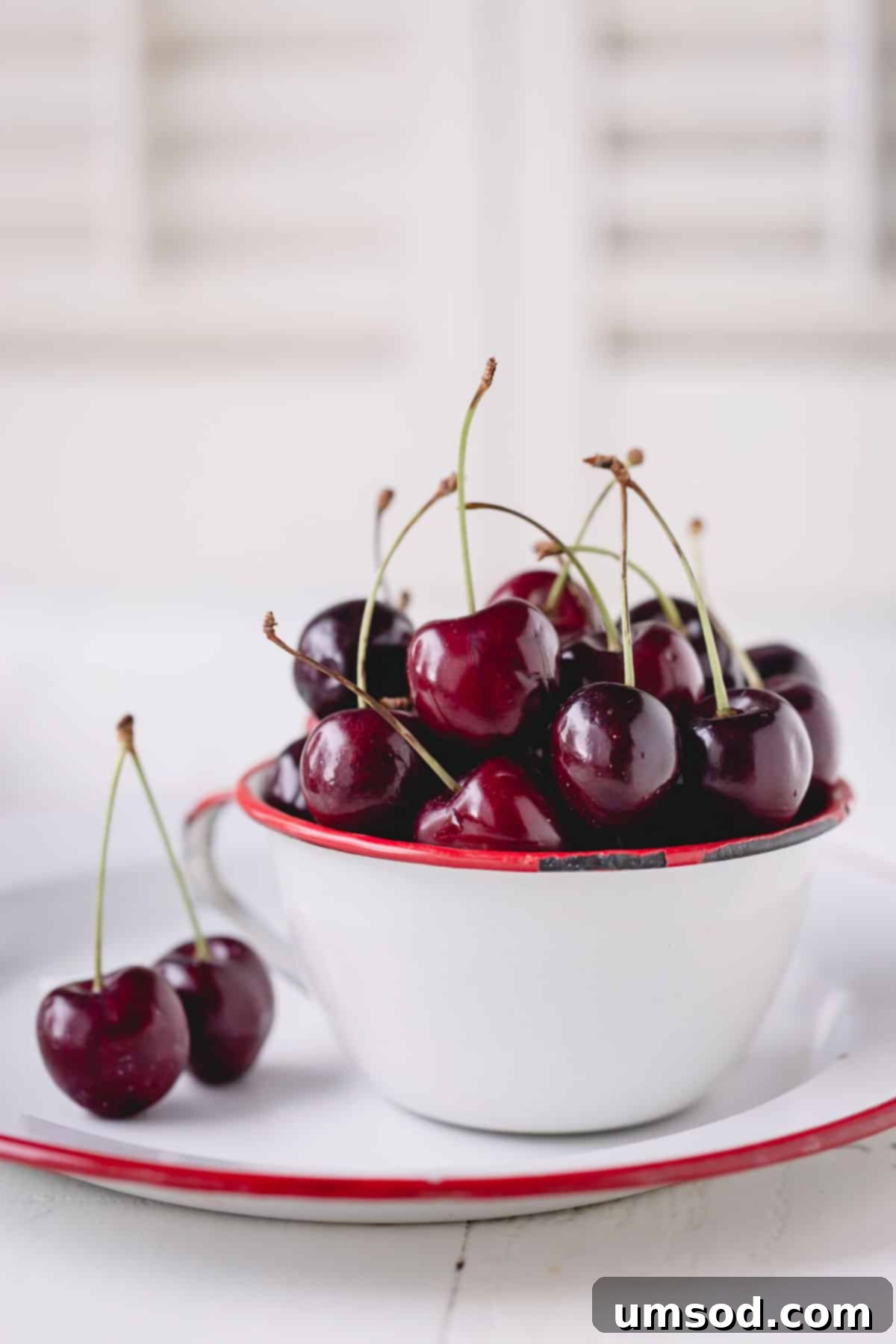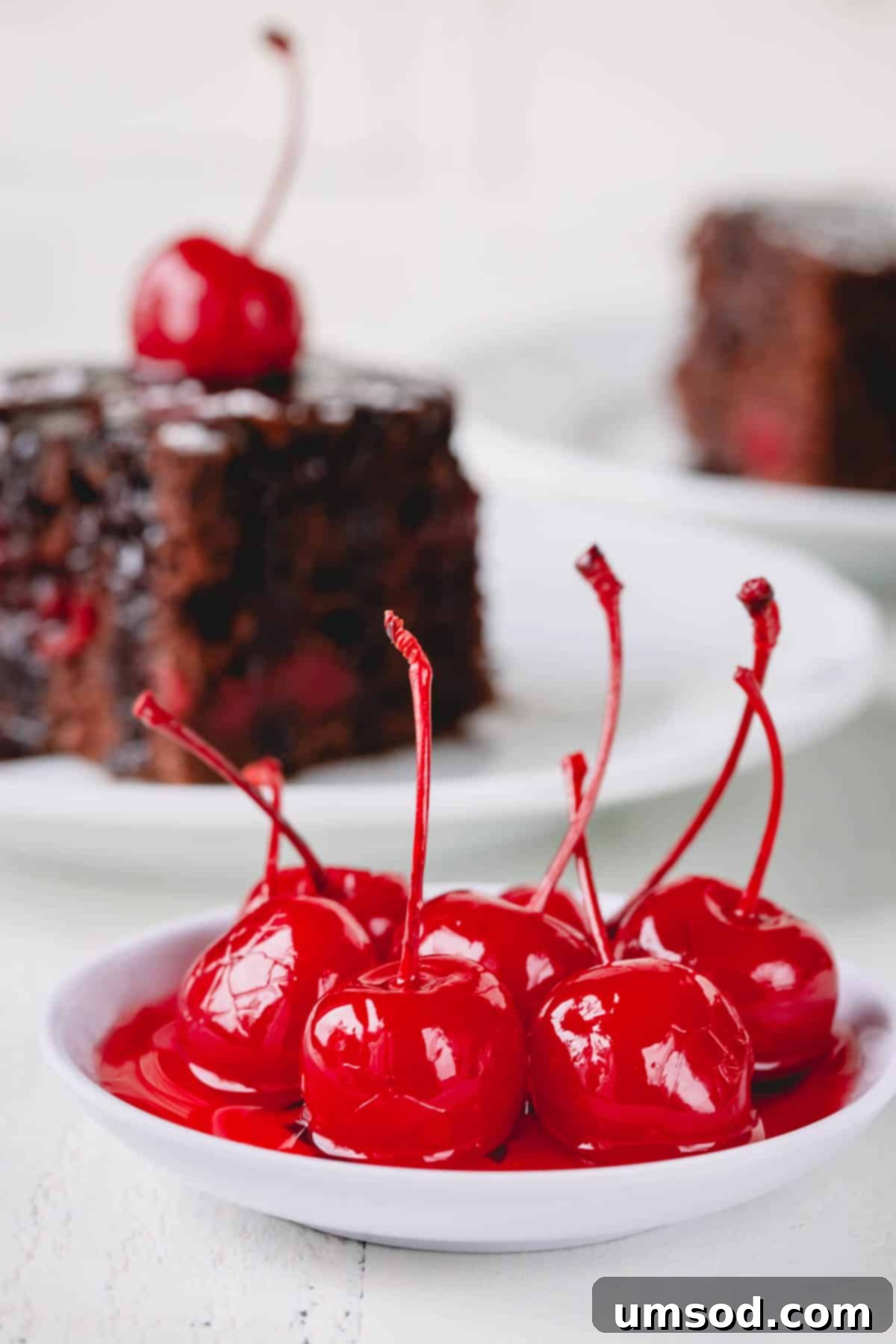Welcome to your comprehensive guide to the vibrant world of cherries! From their tantalizing sweetness to their invigorating tartness, cherries are a quintessential taste of summer that captivate our palates and brighten our tables. This guide, “Cherries 101,” is designed to equip you with everything you need to know about these delightful stone fruits – from understanding their diverse varieties to mastering storage techniques and exploring an abundance of delicious culinary applications. Get ready to celebrate cherry season like never before!

For many, the sight of a generously filled bowl of gleaming red cherries on the kitchen counter unequivocally signals the arrival of summer. This annual ritual is a cherished tradition, a vibrant reminder of longer days, warm sunshine, and nature’s bountiful offerings. Unlike many other fruits that grace our grocery aisles year-round, cherries are a precious, fleeting pleasure. Their season is delightfully brief, typically spanning from late spring through mid-summer, making every moment with them all the more special.
Each year, as supermarket shelves begin to shimmer with large bags of deep crimson and golden-blushed cherries, there’s an irresistible urge to fully immerse ourselves in their seasonal charm. Before they vanish as quickly as they appeared, we’re determined to enjoy them in every conceivable way – from simple, refreshing snacks to elaborate baked goods and preserves. This guide will help you savor every last cherry, ensuring you make the most of this spectacular, albeit limited, window of flavor.
Exploring the Wonderful World of Cherry Varieties
The cherry family is vast and varied, but for culinary purposes, they are broadly categorized into two main groups: sweet cherries and sour (or tart) cherries. While both offer distinct pleasures, their uses in the kitchen differ significantly. Let’s delve into the characteristics that make each type unique and beloved.
Sweet Cherries: Nature’s Perfect Snack
Sweet cherries are celebrated for their luscious, sugary flesh and firm texture, making them ideal for eating fresh right off the stem. With over 800 known varieties cultivated globally, they present a dazzling array of colors, sizes, and sweetness levels. From nearly black to bright yellow, each type offers a subtly different tasting experience.
- Rainier Cherries – Often considered the jewel of sweet cherries, Rainiers are a premium cross-breed, typically between Bing and Van varieties. They boast a delicate, thin yellowish-pink skin, often with a vibrant red blush, encasing a juicy, creamy yellow flesh. Their intensely sweet, almost honey-like flavor, combined with a subtle tart undertone, justifies their higher price point. An added bonus: their lighter flesh means no messy stains on clothes or fingers, making them perfect for elegant snacking.
- Bing Cherries – Undeniably the most popular and widely recognized sweet cherry, the Bing cherry is a quintessential summer fruit. Characterized by its deep, glossy crimson-red skin, firm texture, and richly sweet, juicy flesh, the Bing also carries a delightful hint of acidity that balances its sweetness. These robust trees produce high yields, and the fruit’s sturdy nature makes it exceptionally well-suited for transportation, securing its status as a supermarket staple across the globe. They are excellent for snacking and a versatile choice for many desserts.
- Maraschino Cherries – While not a fresh cherry variety, Maraschino cherries are a well-known processed form of sweet cherries. Traditionally made from Royal Ann, Rainier, or Gold varieties, these cherries undergo a multi-step preservation process that includes brining, sweetening in a sugar syrup, and artificial coloring (typically bright red). Famous for topping milkshakes, ice cream sundaes, cocktails, and fruit salads, they offer a distinct, syrupy sweetness and a playful burst of color.
- Other Sweet Varieties – Beyond these popular types, you might encounter other delicious sweet cherries like Chelan (early-season, firm, dark), Lapins (large, dark, resistant to cracking), Skeena (late-season, firm, sweet), and Sweetheart (heart-shaped, bright red, sweet-tart). Each offers a unique spin on the classic sweet cherry experience.

Sour Cherries: The Baker’s Best Friend
Sour cherries, often referred to as tart cherries, are a completely different culinary experience. Due to their significantly lower natural sugar content, they possess an intense tartness that makes them less suitable for raw snacking. Highly perishable and with a much shorter season than their sweet counterparts, fresh sour cherries can be a rare find, usually appearing in late spring to early summer.
However, their vibrant acidity and robust flavor truly shine when cooked, making them the preferred choice for a multitude of baked goods, jams, jellies, and preserves. Sour cherries are primarily divided into two categories:
- Amarelle Cherries – This type of sour cherry is characterized by its yellow flesh and clear juice. Their skin can range in color from a pale yellow to a brilliant red. The most famous amarelle variety is the Montmorency cherry, which is widely grown in the United States and is the standard for tart cherry pies and preserves due to its perfect balance of tartness and flavor.
- Morello Cherries – In contrast, Morello cherries have a distinctive red flesh and produce dark red juice. They tend to be a bit more tart and have a deeper, richer flavor than amarelle varieties. Balaton cherries are a popular Morello type, known for their firm texture and excellent quality for baking and processing.
When fresh sour cherries are unavailable, which is often the case outside their brief season, canned or frozen tart cherries are excellent substitutes and are widely used by bakers to achieve that signature tangy flavor in pies, crumbles, and sauces.
How to Select the Perfect Cherries
Given the short window of cherry season, knowing how to choose the freshest and most flavorful fruit is paramount. A careful selection process will ensure you bring home only the best. Here are key indicators to look for when buying cherries from your local market:
- Avoid Imperfections: Steer clear of any cherries that appear soft, bruised, wrinkled, or mushy. These are clear signs of overripeness or damage, which will compromise flavor and texture. Split or cracked skins can also indicate poor quality or imminent spoilage.
- Firmness and Density: The ideal cherry should feel plump and firm to the touch, with a satisfying density that suggests juicy flesh within. Gently cup a handful; they should feel heavy for their size, not light and hollow.
- Vibrant Color and Sheen: While color varies greatly by variety, it should always be vibrant and glossy. For red cherries, look for deep, saturated hues – the darker the red, the sweeter and riper they generally are. Rainier cherries should have a distinct yellow base with a pronounced reddish-pink blush. A dull appearance can indicate age or dryness.
- Stems are Key: Always look for cherries with bright green, flexible stems still attached. Stems are a sign of freshness; they help the fruit retain moisture and prevent spoilage. Cherries without stems tend to dehydrate and decay more quickly.
- Aroma: Fresh cherries should have a subtle, sweet, and fruity aroma. Avoid any that smell fermented or overly sweet, as this could indicate spoilage.

Mastering Cherry Storage for Extended Freshness
Proper storage is crucial for preserving the delicate flavor and firm texture of cherries, ensuring you can enjoy them for as long as possible. Follow these simple tips to maximize their shelf life:
- Refrigeration is Essential: Always store fresh cherries in the coldest part of your refrigerator, ideally in a breathable bag or a container lined with a paper towel. This helps maintain their sweet taste and crisp texture. Cherries typically last anywhere from 5 to 10 days when stored correctly in the fridge.
- Keep the Stems On: Resist the urge to remove the stems until you’re ready to eat them. The stems act as a natural protective seal, preventing moisture loss and slowing down the spoilage process. Stemless cherries can quickly shrivel and lose their freshness.
- Avoid Pre-Rinsing: Do not wash cherries until just before you plan to consume them. Excess moisture can accelerate the growth of mold and bacteria, causing them to spoil much faster. Washing them prematurely is one of the most common mistakes in cherry storage.
- Use Cold Water for Rinsing: When it’s time to enjoy your cherries, rinse them gently under cold running water. Warm or hot water can cause the fruit to soften and spoil more quickly by encouraging enzyme activity that breaks down the fruit’s structure.
- Optimal Container Choice: A loosely sealed container or a plastic bag with a few air holes can help maintain humidity without trapping too much moisture, which is ideal for cherry preservation.
Freezing Cherries for Year-Round Delight
Cherry season is wonderfully fleeting, but with a bit of foresight, you can capture their delicious essence to enjoy long after summer has faded. Freezing is an excellent way to preserve cherries, allowing you to incorporate their vibrant flavor into your cooking and baking all winter long. Here’s a simple, step-by-step guide to freezing cherries:
- Prepare a Cold Water Bath: Begin by washing your cherries thoroughly. A good practice is to soak them in a cold water bath with a splash of white vinegar (approximately a 4:1 ratio of water to vinegar) for about 5-10 minutes. The vinegar acts as a natural sanitizer, helping to remove any dirt, pesticides, or potential bacteria.
- Rinse and Destem: After the vinegar bath, rinse the cherries thoroughly under clean, cold water. Then, carefully remove all the stems.
- Pit the Cherries: This is a crucial step for convenience later. Using a cherry pitter is the quickest and most efficient method. Alternatively, you can halve each cherry with a knife and remove the pit manually. Ensuring all pits are removed is vital for safety and enjoyment.
- Flash Freeze: Arrange the pitted cherries in a single layer on a parchment-lined baking sheet. This “flash freezing” technique prevents them from clumping together, making them much easier to portion out later. Place the baking sheet in the freezer until the cherries are completely solid, which usually takes 1-2 hours.
- Transfer to Freezer Bags: Once frozen solid, transfer the cherries from the baking sheet into airtight freezer bags or containers. Label them with the date. Remove as much air as possible from the bags before sealing to prevent freezer burn. Frozen cherries can be stored for up to 6 months, though they are often best within 3 months for optimal flavor and texture.

Expert Tip
When using a cherry pitter, always double-check each cherry after pitting to ensure the pit has indeed been removed. Occasionally, a stubborn pit might remain lodged inside, and accidentally biting into one can be an unpleasant, if not dangerous, surprise. A quick visual or gentle squeeze can save you from this inconvenience!
Delicious Ways to Enjoy Cherries
Whether sweet or sour, cherries offer an incredible range of culinary possibilities. Their unique flavors can elevate everything from simple snacks to gourmet desserts and even savory dishes.
Unleashing the Sweetness of Sweet Cherries
Often dubbed “nature’s candy,” sweet cherries are undeniably delightful on their own, but their versatility extends far beyond simple snacking. Their high natural sugar content and juicy texture make them perfect for a variety of applications:
- Effortless Snacking & Fruit Salads – The most straightforward way to enjoy sweet cherries is fresh out of hand. They also add a burst of color and sweetness to any fruit salad, yogurt parfait, or morning oatmeal.
- Cherry Cake – For a truly special treat, gently press pitted sweet cherries into your favorite cake batter before baking. The cherries infuse the cake with moisture and a delightful fruity flavor. Serve slices warm with a dollop of freshly whipped cream or a scoop of vanilla ice cream.
- Gourmet Cherry Salsa – Create a vibrant and refreshing cherry salsa by finely chopping pitted sweet cherries and tossing them with a squeeze of fresh lime juice or a drizzle of balsamic vinegar, finely minced red onion, a hint of finely diced jalapeño for a kick, and fresh cilantro. This sweet and tangy salsa is a fantastic accompaniment to grilled pork chops, chicken, or even fish tacos.
- Decadent Chocolate-Covered Cherries – Indulge in a classic confection by coating maraschino or fresh sweet cherries in a smooth, rich powdered sugar-based dough, then dipping them in melted dark or milk chocolate. These elegant treats are perfect for special occasions or a luxurious everyday indulgence.
- Smoothies and Shakes – Blend pitted sweet cherries into your morning smoothie for a natural sweetener and nutritional boost. Their rich flavor also makes them a fantastic addition to homemade milkshakes.
The Culinary Magic of Sour Cherries
Sour cherries, with their intense tartness and bright acidity, are the secret ingredient to many beloved desserts. As mentioned, fresh sour cherries are notoriously difficult to find outside their short harvesting period, typically peaking in June and sometimes early July. If fresh aren’t available, don’t despair! Look for canned red tart cherries (packed in water, not syrup, for best control over sweetness) in the baking aisle or high-quality frozen sour cherries in the freezer section of your grocery store.
The acidic profile of sour cherries allows them to cut through rich, sweet dishes, providing a beautiful balance that intensifies and deepens during baking. They are truly unparalleled for:
- Pies and Tarts – The quintessential use for sour cherries! Their tartness perfectly complements the sweetness of sugar and the richness of pie crust, resulting in a perfectly balanced, flavorful filling.
- Jams, Jellies, and Preserves – Sour cherries have naturally high pectin content and a stunning red color, making them ideal for crafting vibrant, tangy homemade jams and preserves.
- Crumbles and Crisps – For a comforting and easy dessert, simply bake pitted sour cherries beneath a buttery, crumbly topping. The tart fruit creates a delightful contrast with the sweet topping.
- Sauces and Glazes – Sour cherry sauces can be incredibly versatile, serving as a dessert topping for ice cream or cheesecake, or as a sophisticated accompaniment to roasted duck, pork, or venison.
- Syrups and Cocktails – Their bold flavor can be simmered into delicious syrups for cocktails, sodas, or drizzled over pancakes and waffles.

The Abundant Nutritional Benefits of Cherries
Beyond their delightful taste, cherries are a powerhouse of nutrition, offering an impressive array of health benefits packed into their small, vibrant forms. They are naturally low in calories, high in dietary fiber, and brimming with disease-fighting antioxidants and beneficial plant compounds. Incorporating cherries into your diet can contribute to overall wellness in numerous ways.
Cherries are particularly renowned for their potent anti-inflammatory properties, largely due to their rich content of anthocyanins – the pigments responsible for their deep red and purple hues. These compounds may help reduce muscle soreness, making cherries a favorite among athletes for post-exercise recovery. Furthermore, tart cherries are a natural source of melatonin, a hormone that regulates sleep cycles, potentially aiding in better sleep quality.
They also support heart health by helping to lower blood pressure and reduce levels of “bad” LDL cholesterol. The fiber content in cherries promotes digestive health and helps maintain stable blood sugar levels. With their blend of vitamins, minerals, and antioxidants, cherries are truly a smart and delicious choice for a healthy lifestyle. Below is a detailed nutritional breakdown for one cup (approximately 154 grams) of sweet, pitted cherries:
- Calories – 95 kcal
- Protein – 2 grams
- Fat – 0.3 grams
- Carbohydrates – 25 grams
- Fiber – 3 grams (contributing to digestive health and satiety)
- Sugars – 19.2 grams (naturally occurring fruit sugars)
- Calcium – 20 mg (important for bone health)
- Magnesium – 17 mg (plays a role in muscle and nerve function)
- Potassium – 333 mg (essential for blood pressure regulation and fluid balance)
- Vitamin C – 10.5 mg (a powerful antioxidant that supports immune function)
Regular consumption of cherries, whether fresh, frozen, or in juice form (especially tart cherry juice), can be a delightful way to boost your nutrient intake and support various bodily functions. For more in-depth information on the health benefits of cherries, you can explore resources like Healthline’s comprehensive article.

Irresistible Cherry Recipe Ideas to Try Now
If you’re anything like us, you eagerly anticipate cherry season as an opportunity to bake and create with these magnificent fruits. From simple everyday treats to show-stopping desserts, cherries lend themselves beautifully to a myriad of recipes. If you’re craving something sweet, look no further! Here are some of our favorite, easy-to-follow cherry recipes guaranteed to be a hit:
- 3-Ingredient Chocolate Cherry Cake – This incredibly moist and fudgy chocolate cake comes together with just three ingredients and is studded with juicy cherries for an unbelievably simple yet decadent dessert.
- The BEST Cherry Pie – Master the art of the classic cherry pie with this recipe, featuring a perfectly flaky, golden crust and a rich, thick, and perfectly sweetened homemade cherry filling that captures the essence of summer.
- Easy Chocolate Cherry Muffins – Start your day or enjoy a delightful snack with these delightful three-ingredient chocolate cherry muffins. They are wonderfully tender, bursting with flavor, and disappear from the plate in no time!
- Cherry Cheesecake Pie – Indulge in the luxurious combination of a velvety smooth, creamy cheesecake base topped with a luscious, scratch-made sweet cherry filling, all nestled in a delicious pie crust.
- Cherry Chocolate Pavlova – Experience a cloud-like dessert with this light and delicate chocolate pavlova. It’s crowned with generous swirls of homemade whipped cream and a vibrant, sweet cherry sauce, offering a harmonious blend of textures and flavors.
- Black Forest Cake – A timeless masterpiece, this Black Forest Cake boasts layers of moist, dark chocolate cake, generously frosted with ethereal white chocolate mousse, and richly adorned with an exquisite homemade cherry sauce. It’s truly an unforgettable dessert experience.
